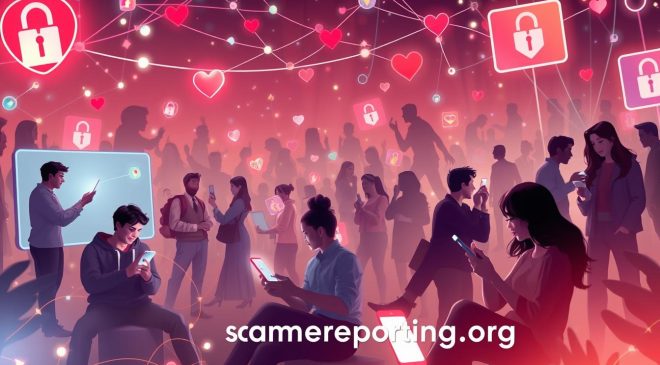
In a quiet suburb of Seattle, Sarah, a software engineer, got a call from what seemed like her bank. The caller sounded just like her usual account manager, warning her of suspicious activity on her account. Sarah was about to give out her info, but something didn’t feel right. It was an AI-powered phishing attempt.
This close call shows a big threat in cybersecurity. As AI gets better, so do the tricks of online fraudsters. Voice phishing, or “vishing,” is now a big business, with scammers running advanced call centers that make billions illegally around the world.
The rise of AI in fraud is scary. In 2019, thieves used AI to sound like a CEO, tricking a company out of $250,000. This shows we really need strong AI tools to protect our online identities.
Online fraud prevention is getting tougher, and AI plays a big role. AI helps cybercriminals with new tools, but it also gives us strong ways to fight back. Now, advanced machine learning can spot the tiny patterns in fake messages, helping us stay safe from new threats.
Key Takeaways
- AI-powered phishing attempts are becoming more sophisticated and harder to detect.
- Voice phishing (vishing) and SMS phishing (smishing) are lucrative industries for cybercriminals.
- AI can mimic voices convincingly, leading to high-stakes fraud attempts.
- Machine learning algorithms are crucial in detecting and preventing AI-driven phishing attacks.
- Staying informed about evolving cyber threats is essential for protecting digital identities.
Understanding the Threat of Digital Identity Theft
Digital identity theft is a big worry in our connected world. With more cyber threats and online scams, it’s key to be careful and guard our personal info.
The evolution of online scams
Online scams have changed a lot over time. Now, cybercriminals use smart tricks to fool people. In December 2023, a big data leak showed 2.9 billion personal records, including Social Security numbers. This shows how big the problem of digital fraud is and why we need better cybersecurity.
Voice phishing and SMS phishing
Voice phishing and SMS phishing are new ways scammers steal identities. They use phone calls or texts to make people share private info. Scammers pretend to be from banks or government agencies, saying there’s a problem with your account to get your details.
The lucrative industry of digital fraud
Digital fraud is a big money-maker. Criminals run big networks, like call centers, making lots of money. Losing your personal info can cause big financial losses, hurt your credit score, and have lasting effects on you.
| Scam Type | Method | Potential Impact |
|---|---|---|
| Vishing | Phone calls | Financial loss, identity theft |
| Smishing | Text messages | Data breach, account compromise |
| Email phishing | Deceptive emails | Malware infection, credential theft |
To keep your identity safe, check your bank and credit statements often, use two-factor authentication, and think twice before sharing personal info online. If you think your data has been stolen, report it to the authorities and act fast to protect your accounts.
The Role of AI in Modern Phishing Attacks
AI has changed the game in cybercrime, making phishing attacks smarter and harder to spot. Now, cybercriminals use advanced tech to create scams that can trick even the most careful people.
AI-generated Voice Technology in Fraud
Voice cloning is a big deal for fraudsters now. In a scary case, crooks used AI to sound like a top executive, swiping $250,000. This shows how AI-driven voice tricks are a big threat in financial fraud.
Real-time Translation and Voice Forgery
AI helps with real-time translation and voice changes, making vishing and smishing more powerful. Scammers can now send convincing messages in many languages, reaching more people worldwide.

Lowered Barriers for Malicious Actors
Deepfake tech has made it easier for new scammers to get into the game. They can now make fake videos and audio that looks and sounds real, making it hard for victims to tell what’s real and what’s not.
| AI Technology | Fraudulent Use | Potential Impact |
|---|---|---|
| Voice Cloning | Executive Impersonation | Financial Losses |
| Real-time Translation | Global Phishing Campaigns | Increased Victim Pool |
| Deepfake Video | Identity Theft | Reputational Damage |
As AI gets better, so do the tricks of cybercriminals. It’s important to keep up with these new threats to protect your online identity in today’s complex digital world.
AI Phishing Detection: A Powerful Countermeasure
AI security solutions are now a key defense against cyber threats. They use machine learning to check for phishing attempts right away. As fraudsters get smarter, AI tools keep up, protecting our online identities well.
AI is great at catching things humans might miss. It looks at lots of data fast and finds small oddities in emails, sender info, and network traffic.
- Rapid threat identification
- Continuous learning from new attack patterns
- Automated response to potential threats
- Reduction in false positives
Big tech companies like Microsoft and IBM are adding AI to their security. They use AI to spot risky sign-ins, malware, and fake accounts. This makes fighting fraud much more effective.
| AI Security Feature | Benefit |
|---|---|
| Real-time analysis | Instant threat detection |
| Behavioral biometrics | Enhanced user authentication |
| Predictive analytics | Anticipation of future threats |
As cyber threats change, we need to keep improving AI security. The U.S. government sees AI’s value in protecting digital worlds in many areas.
Common Phishing Techniques and How AI Detects Them
Phishing tactics have become more complex and harder to recognize. Cybercriminals use social engineering to exploit human weaknesses. This makes AI threat detection key in fighting these tactics.
The Rise of “Pig Butchering” Scams
“Pig butchering” scams are a big worry in online fraud. These scams start by building trust with victims over time. Then, fraudsters ask for a lot of money. AI systems look for signs of these long-term scams by analyzing how people communicate.

Cryptocurrency Fraud: A Digital Gold Rush for Scammers
The rise of cryptocurrency has brought new fraud opportunities. Scammers pretend to be real crypto platforms or offer fake investment deals. AI tools can spot unusual transactions and fake websites, keeping users safe from these scams.
Romance Scams and Tech Support Hoaxes
Romance scams target emotional weaknesses, while tech support hoaxes use fear and urgency. AI can spot the language patterns of these scams, warning users of danger. Machine learning helps AI keep up with new phishing methods, offering strong protection against threats.
| Phishing Technique | AI Detection Method |
|---|---|
| Pig Butchering Scams | Analysis of long-term communication patterns |
| Cryptocurrency Fraud | Monitoring of transaction anomalies and website authenticity |
| Romance Scams | Recognition of emotional manipulation language |
| Tech Support Hoaxes | Identification of urgency and fear-inducing tactics |
As phishing methods get more complex, AI solutions are crucial in cybersecurity. They protect users from advanced digital threats.
The Data Trade Industry: How Your Information Becomes Vulnerable
The data trade industry has grown fast as old directories become less used. Data brokers collect personal info from public records, commercial databases, and online tracking. They then sell this info to others, sometimes to bad actors.
Personal info security is at risk because data brokers collect and sell sensitive info like phone numbers and email addresses. A 2022 Consumer Reports survey found 75% of people worry about online data collection.

Data brokers greatly affect online privacy. When personal info is sold, people face more risks like scams, identity theft, and unwanted ads. This shows we need better rules and to be more careful with our online identities.
| Data Broker Activity | Impact on Personal Information Security |
|---|---|
| Collection of public records | Exposure of personal details |
| Online tracking | Detailed profiling of online behavior |
| Sale of data to third parties | Increased risk of targeted scams |
| Aggregation of commercial data | Comprehensive personal profiles |
To keep your info safe, be careful with what you share online. Check your privacy settings on social media often. Use privacy-focused services and tools to reduce your online presence and protect your privacy.
Protecting Your Phone Number from Cybercriminals
In today’s digital world, keeping your phone safe is key to your online security. With more scams and data breaches, it’s vital to protect your phone number.
Avoiding Unexpected Calls and Messages
One top tip is to ignore calls and texts from numbers you don’t know. Scammers often try to contact you this way to get your personal info. A 2022 survey by Consumer Reports found 75% of people worry about their data, including phone numbers, being shared online.
Implementing Two-Factor Authentication (2FA)
2FA adds an extra security step to your accounts. Use apps or biometrics instead of SMS for 2FA to avoid risks. This makes it harder for hackers to get into your accounts, even if they have your phone number.

Utilizing Government Services
The “Do Not Call” registry helps cut down on unwanted sales calls. By signing up, you lower the risk of your number being shared by telemarketers.
| Cybersecurity Measure | Benefit | Implementation Difficulty |
|---|---|---|
| Ignore Unknown Calls/Messages | Prevents initial contact with scammers | Easy |
| Use 2FA | Adds extra security layer to accounts | Moderate |
| “Do Not Call” Registry | Reduces unwanted calls | Easy |
By using these steps, you can lower the chance of being targeted by cybercriminals and keep your online identity safe.
AI-Powered Solutions for Personal Cybersecurity
AI cybersecurity is changing how we protect our digital lives. With more complex cyber threats, machine learning security is key to keeping our online identities safe.
Machine Learning Algorithms for Threat Detection
Advanced AI systems use complex algorithms to find potential dangers. They look at patterns and behaviors to spot suspicious activities early. For instance, in India, there were 3163 cyber attacks every week, showing the need for strong AI security.

Real-time Analysis of Communication Patterns
AI watches our communication in real-time, catching phishing attempts and harmful content. This is crucial since 1 in 4 Indian organizations faced a cyber attack in July 2024. AI can spot threats like Joker spyware and Anubis banking trojans, which were top threats globally.
Automated Security Updates and Patches
Automated systems apply updates quickly to keep devices safe. This is crucial as cybercriminals target public Wi-Fi during holidays. AI-driven solutions provide ongoing protection against new threats.
| Threat Type | Detection Method | AI Solution |
|---|---|---|
| Spyware (e.g., Joker) | Behavior Analysis | Pattern Recognition AI |
| Banking Trojans (e.g., Anubis) | Network Traffic Monitoring | Deep Learning Algorithms |
| Remote Access Trojans (e.g., AhMyth) | Anomaly Detection | Machine Learning Models |
By using these AI-powered solutions, we can greatly improve our personal cybersecurity. This helps us stay ahead of cyber threats in our digital world.
Steps to Take if Your Personal Data is Compromised
If you think your personal data has been leaked, act fast. First, reach out to the Federal Trade Commission at IdentityTheft.gov or call 877-438-4337. They’ll give you a plan to help you recover from identity theft.
Then, file a report with the Internet Crime Complaint Center. This action helps track and fight cybercrime. Also, tell the Internal Revenue Service to stop tax fraud, a common issue after data breaches.
After a breach, it’s key to monitor your credit. Visit www.annualcreditreport.com to check your credit reports often. Watch for any odd activities or unknown accounts. If you find something fishy, report it right away to the credit agencies.
If your Social Security number was leaked, contact the Social Security Administration. They can review your statements and help you protect yourself. In bad cases, you might need a new Social Security number. But, this is hard and needs strong proof.
- Enable two-factor authentication on all your accounts
- Change passwords for all your online accounts
- Be cautious of unexpected calls or emails asking for personal information
- Consider using encryption when sharing sensitive data electronically
Quick steps in responding to a data breach can greatly lower the risk of identity theft and financial loss. Always be alert and get professional help if you need it.
The Future of AI in Cybersecurity and Identity Protection
The future of cybersecurity is looking bright with AI innovations leading the way. These advancements will change how we keep our digital identities safe and fight online threats.
Advancements in behavioral biometrics
AI-powered behavioral biometrics are changing how we log in. They look at how each person uses devices uniquely. This makes logging in safer and smoother, even if passwords are stolen.
Integration of AI with blockchain technology
AI and blockchain together will make our defenses stronger. They will make data safer and more open. For example, blockchain can check if AI-made content is real, fighting fake news and deepfakes.
Predictive analytics for threat prevention
AI in predictive analytics is a big deal for cybersecurity. It looks at lots of data to guess where attacks might come from. This way, we can stop threats before they start, keeping us ahead of hackers.
FAQ
What are the common techniques used in phishing attacks?
Phishing attacks often use “pig butchering” scams, where fraudsters gain trust to steal money. They also use cryptocurrency fraud, romance scams, and tech support hoaxes.
How can AI help in detecting phishing attempts?
AI can spot patterns in messages and flag suspicious requests for personal info. It also catches phishing links or attachments. Machine learning helps recognize new scams quickly.
How does the data trade industry contribute to personal information vulnerability?
Data brokers collect info from public records and online tracking. They sell this to others, including criminals. This makes personal details like phone numbers and emails easy to get.
What steps can be taken to protect phone numbers from cybercriminals?
Don’t answer calls or messages from unknown numbers. Avoid clicking on links you don’t know. Use two-factor authentication (2FA) and government services like the “Do Not Call” registry.
How can AI-powered solutions enhance personal cybersecurity?
AI solutions use machine learning for better threat detection. They analyze messages to spot phishing. They also update security automatically to protect against threats.
What actions should be taken if personal data is compromised?
Contact the Federal Trade Commission at IdentityTheft.gov right away. Tell the Internal Revenue Service and file a complaint with the Internet Crime Complaint Center. Check credit reports often. In bad cases, think about getting a new Social Security number.
What advancements are expected in the future of AI for cybersecurity and identity protection?
Future advancements include better behavioral biometrics for user checks. AI will work with blockchain for safer data and more transparency. Predictive analytics will help prevent threats and defend against them.


